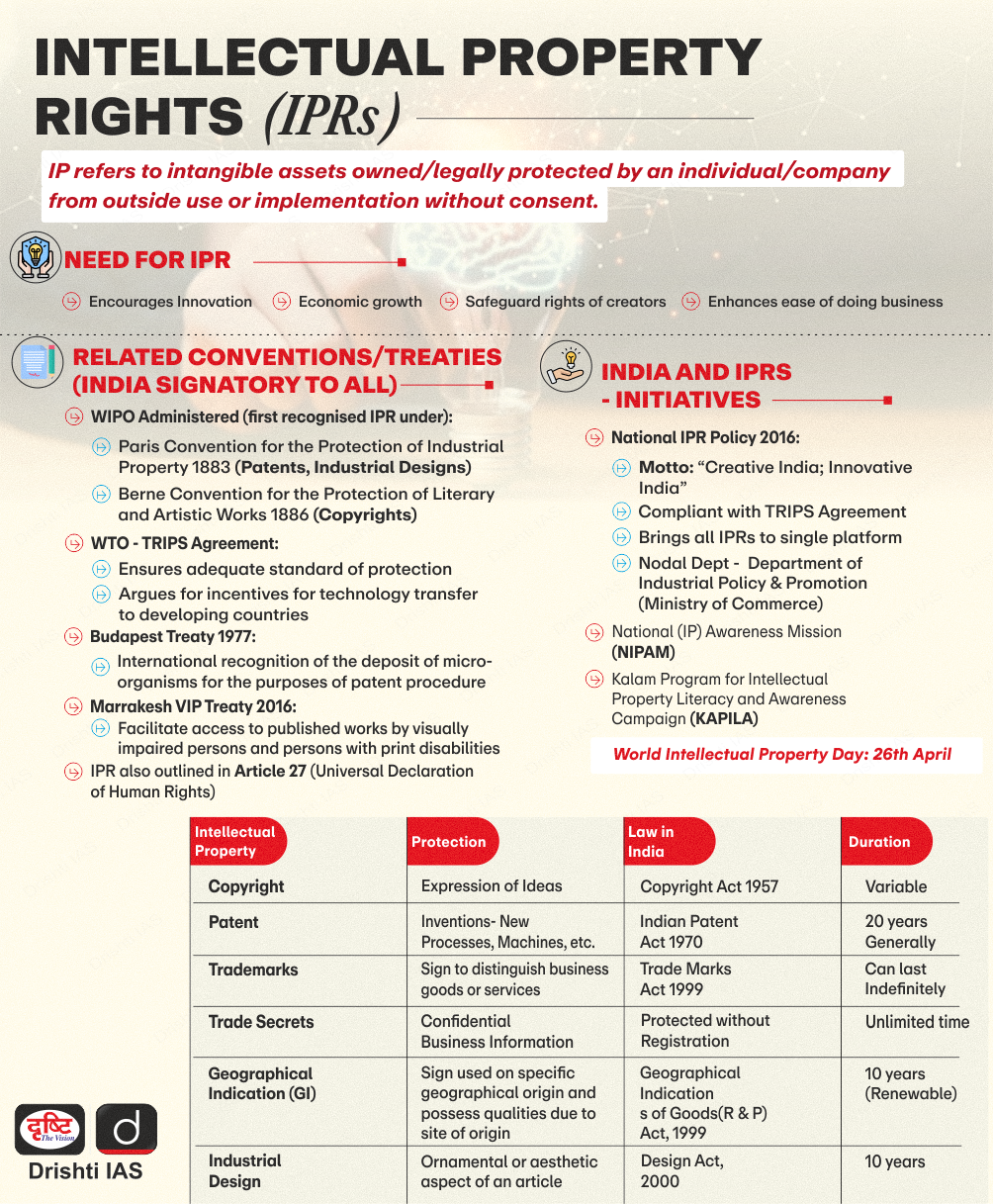Indian Economy
Stagnation of India’s Patent Growth
- 24 Feb 2025
- 7 min read
For Prelims: Intellectual Property Rights, World Intellectual Property Organization, Venture capital
For Mains: Intellectual Property Rights (IPR) in India, Digital Patent Filing and AI in IPR Protection
Why in News?
India's Intellectual Property Rights (IPR) ecosystem has grown significantly over the past decade. However, patent applications stagnated in 2024, with very few approvals, raising concerns that low private-sector Research and Development (R&D) investment is limiting innovation.
What are the Key Trends in India's IPR Ecosystem?
- Increase in Patents: India now ranks 6th globally in terms of patent applications, with 64,480 patent filings in 2023.
- Patent applications grew from 42,951 (2013-14) to 92,168 (2023-24), with grants rising due to backlog clearance.
- In 2013-14, 25.5% of patent applications were from Indian residents, which increased to 56% in 2023-24.
- Earlier, patent filings were dominated by foreign multinational corporations, but Indian applicants are now filing more patents.
- However, in 2024-25, 78,264 patent applications and 26,083 grants indicate a lower approval rate.
- Trademarks: According to the World Intellectual Property Organization (WIPO) 2024 report, India ranked 4th globally in trademark filings after the US, China, and Russia.
- Trademark applications in India have indeed grown significantly from around 2 lakh in 2016-17 to approximately 4.8 lakh in 2023-24. However, the rate of increase has slowed.
- Industrial Design: 36.4% increase in industrial design applications, driven by textiles, tools & machines, and health sectors.
- Manpower: The patent office workforce increased from 272 in 2014-15 to 956 currently, but still lags behind China (13,704) and the US (8,132).
What are the Challenges in India’s Patent Ecosystem?
- Low R&D Investment: India’s R&D spending is just 0.65% of GDP (compared to the US (3.6%), China (2.4%), Singapore (2.2%)).
- The private sector contributes only 36% to R&D, whereas it accounts for 79% in the US and 77% in China.
- Many Indian companies operate at a global scale but invest little in R&D, limiting patent filings.
- High Dependence on Foreign Patents: Despite rising domestic filings, foreign entities dominate Patent approvals (74.46% in 2022), far exceeding China’s 12.87%.
- India remains reliant on imported technology, leading to a trade deficit and reduced self-reliance in innovation.
- Manpower Shortage: Patent examination capacity is limited due to a lack of skilled examiners. Fewer examiners lead to long processing delays and lower patent approval rates.
- On average, it takes about 58 months to grant a patent in India, compared to 21 months in the US.
- Quality of Patent Applications: Domestic patent filings lag in approvals due to poor-quality applications, weak research, plagiarized content, and lack of resources in startups.
- Weak IP Enforcement: Patent infringement cases are rising in India, but weak enforcement and judicial backlogs hinder effective protection.
- Indian firms often lack the expertise to navigate the global IP system effectively. In the digital age, easy copying, anonymous infringers, and cross-border piracy further complicate IP enforcement.
Way Froward
- Ease of Patent Filing: Streamlining digital patent processing with AI-driven IP infringement detection systems can increase patent filling.
- Tax incentives for corporate R&D spending and increased venture capital funding can drive deep-tech advancements and boost patent filings.
- Enforcement and Legal Framework: Set up specialized IP courts to resolve patent disputes faster. Increase penalties for copyright infringement to deter violations under Copyright Act 1957.
- Global Partnerships for Innovation: Participate in global patent treaties like the Riyadh Design Law Treaty to simplify cross-border filings and attract foreign investment in strengthening India's IP ecosystem.
- IP Awareness: Integrate IP education into curricula and conduct awareness programs in universities and businesses.
- Encourage joint R&D projects with international institutions like WIPO to enhance the quality and quantity of domestic patent filings.
|
Drishti Mains Question: India has shown remarkable growth in IP filings, yet challenges persist. Critically analyze the key factors affecting India’s IPR ecosystem. |
UPSC Civil Services Examination, Previous Year Questions (PYQs)
Prelims
Q. Consider the following statements: (2019)
- According to the Indian Patents Act, a biological process to create a seed can be patented in India.
- In India, there is no Intellectual Property Appellate Board.
- Plant varieties are not eligible to be patented in India.
Which of the statements given above is/are correct?
(a) 1 and 3 only
(b) 2 and 3 only
(c) 3 only
(d) 1, 2 and 3
Ans: (c)
Q. With reference to the ‘National Intellectual Property Rights Policy’, consider the following statements:(2017)
- It reiterates India’s commitment to the Doha Development Agenda and the TRIPS Agreement.
- Department of Industrial Policy and Promotion is the nodal agency for regulating intellectual property rights in India.
Which of the above statements is/are correct?
(a) 1 only
(b) 2 only
(c) Both 1 and 2
(d) Neither 1 nor 2
Ans: (c)
Mains
Q. In a globalized world, Intellectual Property Rights assume significance and are a source of litigation. Broadly distinguish between the terms—Copyrights, Patents and Trade Secrets. (2014)






